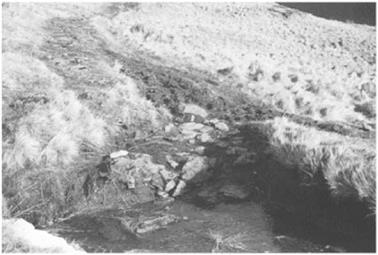This is a method that has been used for hundreds of years. Bundles of brushwood, slash from logging or similar materials are compressed tightly and bound using wire or nylon twine. The faggots are laid side by side lengthways across the path. They should be longer than the path width, because light wooden poles of around 75 mm (3 in.) diameter are used to hold them together and define the width. Wooden stakes are
 |
An example of an eroded path across peat. This is extremely difficult to restore or to lay a satisfactory path surface over.
(Courtesy Peter Ford)
|
|
Rafting construction using lengths of timber
wired together into a continuous mat.
This is laid straight onto the surface once any basic preparation has been carried out. Path surfacing is laid over this, covering the timber to keep out the air.
partly driven in at intervals next to the poles and nailed to them. They are then driven in further. This has the effect of compressing the faggots and clamping them in place. Crushed rock can then be laid over the faggots and turves laid over the exposed ends along the path edge. Deeper holes can be filled with piles of faggots.
|
Path construction using fascines or faggots of brushwood pegged into place and covered with crushed stone. This is an old, well-tried method. |





